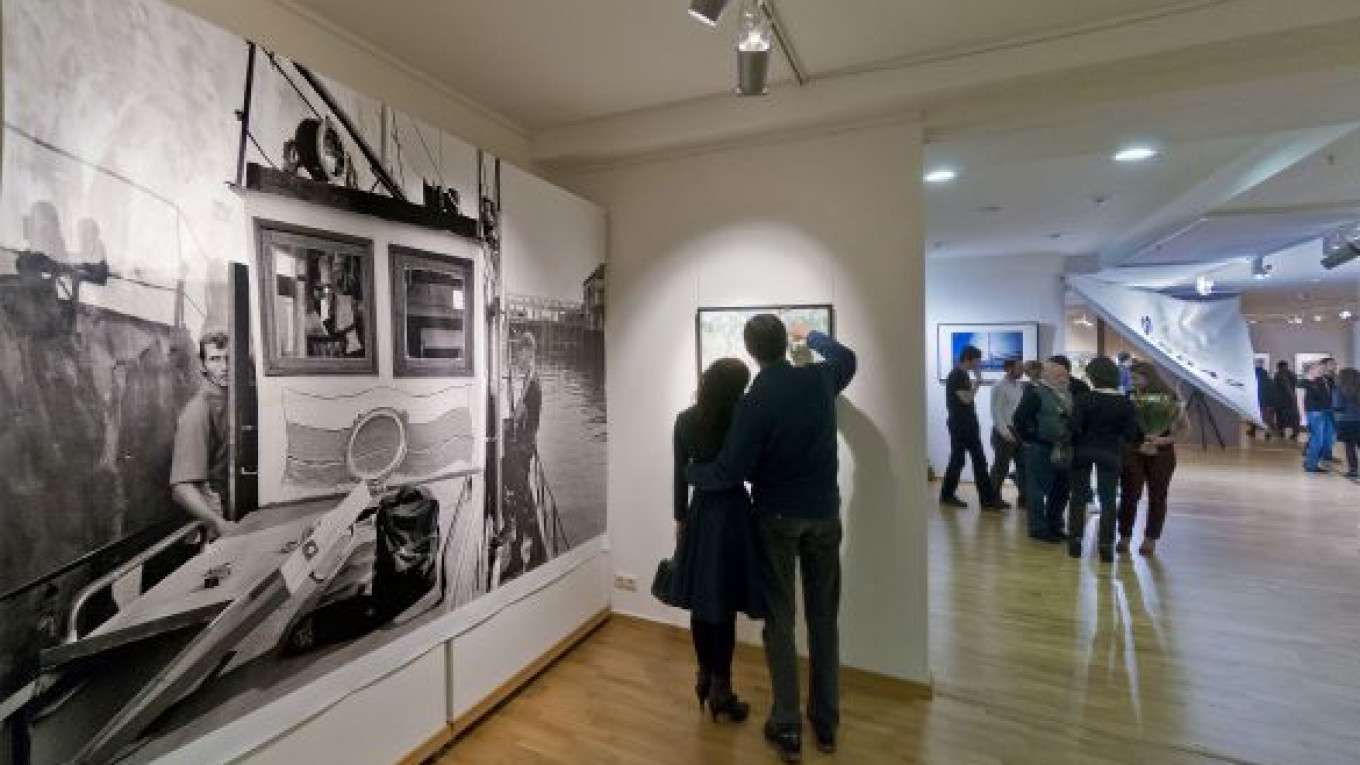When most people think of traveling across the vast expanses of Russia, which has a greater surface area than the planet Pluto, they think of equally large and impressive forms of transportation, like the Trans-Siberian Railroad. However, one group of photographers earlier this year decided to take the road — or series of rivers, seas and canals — less traveled by and adventured through the western half of the country in a small boat.
A pair of new exhibitions at the Gallery of Classical Photography explores different visions of Russia's far north. The larger of the two exhibitions, "From the White to the Black Sea: North," shows the first half of a photography expedition from St. Petersburg to the Black Sea taken on a yacht named the "Freelancer."
The show consists of 120 black-and white photos from nine photographers who spent time aboard the ship from June through September as it made its way through the White Sea and the Baltic-Volga Waterway to a resting point in Tatarstan. Captained by the project's driving force, Oleg Klimov, the crew hopes to continue its journey towards the Black Sea next year.
Klimov, who is experienced as a war photographer and had previously done a month-long trip on the Volga River, was the only member of the team with sailing experience. Although the resulting collection of photos, which shows the leathery faces, striped sailor shirts and long beards of local inhabitants, are impressive in their ability to show life along the country's waterways, the trip was done with very little planning of who or what to shoot.
Artyom Lezhepekov, a St. Petersburg native who accompanied Klimov the entire journey, said, "It was difficult, we had no contacts, no people that we properly got accustomed to, no Internet, no electricity for periods of time and in general there was very little information." He added that the sailor-photographers often did not have time to shoot because they were busy manning the yacht.
The resulting spontaneity of the shots and the fact that various objects from the crew like the Freelancer's sail are interspersed throughout the expedition gives viewers the sense that they are looking at the personal journeys of the travelers. The photos could be mementos that friends show after a long road trip, provided of course that the friends are all documentary photographers.
Acknowledging that the crew also considered themselves artists in addition to documentarians, Klimov said by e-mail that he sees the project more as "new journalism," telling the story of the photographers' expedition through snapshots that give a sense of the emotional aspect of the team's travels.
The various photographers give different senses to their respective journeys. Some focused on the modern day life, taking shots of young women preparing for an amateur video shoot in front of the Volga or teenagers preparing for a local disco. Others like Klimov delved into the history of the places they visited — summarized in the crew's writings on display at the exhibition — and heard stories like those from residents of an island in the Rybinsk reservoir who had survived eviction attempts from both Stalin and contemporary oligarchs who wanted to turn their home into a hotel for business executives.
The serious weight of history also mixes with the lighthearted attitudes of travelers that can be seen in videos of the sailors playing guitar or the funny subjects of Lezhepekov's photos, such as the contrast between a plump older woman and a young thin girl in bathing suits or a row of footballers bracing themselves for an oncoming free kick. The smaller moments that caught the photographer's eye give little glimpses into his personal river odyssey.
The sailing expedition exhibition, which occupies the building's upper floor, is joined below deck by another show looking at the Russia beyond Moscow called, "Two Norths," with photos from Dmitry Spodarenko that focus on the wilderness of both the Chukotka autonomous district and Arkhangelsk region. The show's subject matter may lead potential visitors to think that the photos could be indistinguishable from the white walls next to them, the landscapes, many of which were taken in autumn, are full of alien-looking tundra and trees in reds and oranges. The pictures give a mysterious air to the lands of less-populated areas of Russia and could fan the flames of viewer's wanderlust.
Both exhibits are on display until the first week of December at the Classical Photography Gallery, 23 Savvinskaya Naberezhnaya, Bldg. 1. Metro Sportivnaya.
Contact the author at [email protected]
A Message from The Moscow Times:
Dear readers,
We are facing unprecedented challenges. Russia's Prosecutor General's Office has designated The Moscow Times as an "undesirable" organization, criminalizing our work and putting our staff at risk of prosecution. This follows our earlier unjust labeling as a "foreign agent."
These actions are direct attempts to silence independent journalism in Russia. The authorities claim our work "discredits the decisions of the Russian leadership." We see things differently: we strive to provide accurate, unbiased reporting on Russia.
We, the journalists of The Moscow Times, refuse to be silenced. But to continue our work, we need your help.
Your support, no matter how small, makes a world of difference. If you can, please support us monthly starting from just $2. It's quick to set up, and every contribution makes a significant impact.
By supporting The Moscow Times, you're defending open, independent journalism in the face of repression. Thank you for standing with us.
Remind me later.






